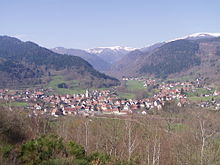
A truncated upland, truncated highland or bevelled upland (German: Rumpfgebirge) is the heavily eroded remains of a fold mountain range, often from an early period in earth history.[1][2] The term Rumpfgebirge ("rump mountains") was first introduced into the literature in 1886 by Ferdinand von Richthofen.[3] The rumps of the former mountain ranges may be found in many lowland regions of the Earth's crust (where they form the so-called basement rocks) and especially outcrop in Central Europe through more recent tectonics. This could result in an uplifted peneplain which is one type of truncated upland.
The valley structures of truncated uplands are often more irregular than in the younger fold mountains, which is due to the considerably younger tectonic processes and stronger erosion of the former mountain ranges that were originally often up to several thousand metres high. By contrast, their plateaux are orographically similar in shape.
- ^ Murawski, H., Meyer, W. (2004): Geologisches Wörterbuch. Spektrum Akademischer Verlag, 11th edn., 262 pp. ISBN 3-8274-1445-8
- ^ Leser, Hartmut, ed. (2005). Wörterbuch Allgemeine Geographie, 13th ed., dtv, Munich, p. 778. ISBN 978-3-423-03422-7.
- ^ Ferdinand von Richthofen (1886), Führer für Forschungsreisende : Anleitung zu Beobachtungen über Gegenstände der physischen Geographie und Geologie (Online) (in German), p. 654
© MMXXIII Rich X Search. We shall prevail. All rights reserved. Rich X Search
